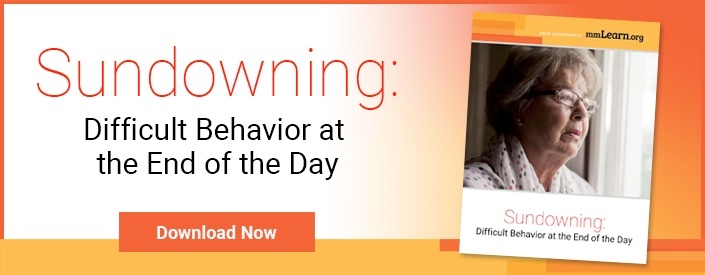Much like the name indicates, sundowning syndrome is a complex medical condition that occurs when a person becomes confused or agitated at nightfall. People who experience sundowning frequently have a diagnosis of dementia, but the condition can also affect those who do not.

Caring for or living with someone who experiences sundowning syndrome can be difficult. The behaviors associated with the condition can significantly affect the lives of a patient’s caregivers and family members. Sundowning can make caregiving frustrating, difficult and exhausting. Fortunately, there are steps you can take to address the issue.
How do you know if someone is experiencing sundowning syndrome? Learning which behaviors characterize this condition is a first step toward helping reduce the occurrence or severity of episodes.
More characteristics of sundowning
The name offers a clue to the nature of the condition, which is characterized by nervous, restless and sometimes disruptive behaviors that begin around sunset and may last into the night. Unlike delirium, this collection of behaviors tends to only occur during the evening hours.
Behaviors you may observe in someone experiencing sundowning syndrome include:
- Confusion
- Anxiety
- Agitation
- Aggressiveness
- Restlessness
- Panic
- Increased motor activity like pacing or wandering
- Resistance to redirection
- Increased verbal activity like yelling
These behaviors may be present in any combination, but their key characteristic is that they will become worse around nightfall and may continue throughout the evening.
Sometimes those who are suffering a sundowning episode may even experience hallucinations. They may also exhibit behaviors like refusing to take medication, blurring the lines between reality and dreams, or insisting ongoing “home” to their children even if they live in a nursing home or assisted living facility.
Worsening symptoms at nightfall
Even if a person has dementia and displays symptoms of that condition during the day, they will seem even more confused, nervous, and tense when experiencing sundowning. Their symptoms will escalate above their baseline of behaviors during the daytime. Occurrences of sundowning may vary in intensity and duration from person to person or day to day.
Knowing what behaviors define sundowning is the first step toward identifying the condition. It also helps to understand more about what sundowning is and what is known about it from a research perspective. Once you know that someone is experiencing sundowning syndrome, you can take practical steps to help reduce the frequency and intensity of episodes by minimizing risk factors for sundowning. That can help improve the caregiving experience for everyone involved.
For more information on caring for a person with sundowning, including coping strategies, read our online guide to sundowning syndrome.

